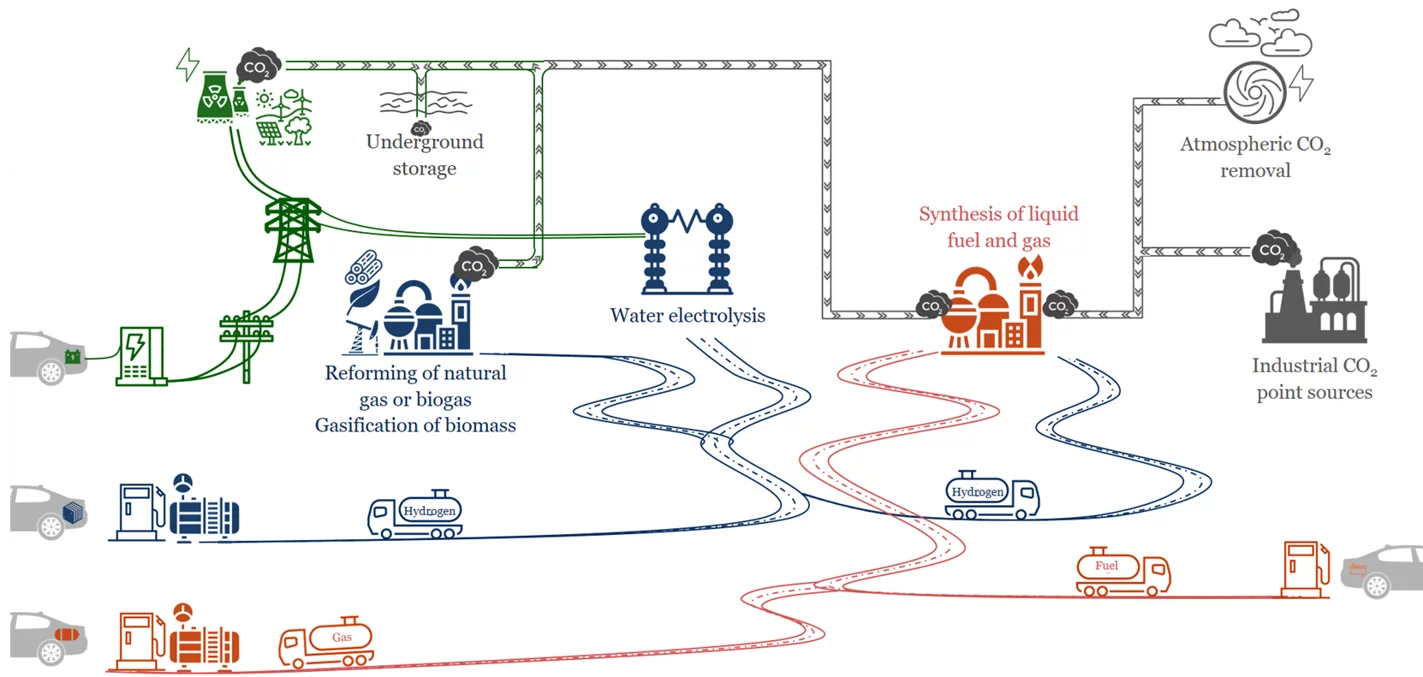Sustainable, synthetic fuels, so-called e-fuels, can help reduce CO₂ emissions. For their production, electricity from renewable sources is required in order to allow for a close to CO₂-neutral balance. The electricity is used for the electrolysis of water, which then produces hydrogen. This hydrogen is combined with CO₂ from various sources and converted into synthetic hydrocarbons, which can replace fossil hydrocarbons such as diesel, kerosene, or gasoline. The availability of electricity from renewable sources, which ensures the climate benefits of e-fuels, is currently still limited. “Especially in order to produce on a larger scale, a lot of renewable electricity is needed,” explains Christian Bauer, researcher at the Laboratory for Energy Systems Analysis (LEA) at PSI. In his work, he addresses the question of the efficiency of different energy systems.
Hydrogen-based e-fuels should primarily be used in sectors such as aviation or industrial processes that cannot be electrified directly and where e-fuels are to date the only way to reduce CO₂ emissions. To serve these sectors the research and production of synthetic flight kerosene are worthwhile. On the other hand, producing these fuels to broadly replace fossil fuels for instance in cars or for heating houses is too inefficient, costly and their availability too uncertain. For most sectors, directly using electricity for instance in battery-electric cars or heat pumps makes more sense – both from an economic and from an environmental perspective. Broadly relying on hydrogen-based e-fuels instead and keeping combustion technologies threatens to lock in further fossil fuel dependency and greenhouse gas emissions.
Hydrogen-based e-fuels can be a great, clean energy carrier – they can, however, also be a bit of a false promise. While they are very versatile, it should not be expected that they broadly replace fossil fuels. Hydrogen-based e-fuels will likely be scarce and not competitive for at least another decade. Betting on their large-scale use would likely prolong fossil fuel dependency: clinging to combustion technologies and hoping to feed them with hydrogen-based e-fuels might lead to further burning oil and gas and emitting greenhouse gases, if e-fuels turn out to be too costly and scarce. This endangers short- and long-term climate targets.
Prioritizing applications like aviation and steel production
Hence, those precious hydrogen-based e-fuels should be used in applications for which they are indispensable: long-distance aviation, feedstock in chemical production, steel production and potentially some high-temperature industrial processes. These are sectors and applications that can hardly be electrified directly.
So-called green hydrogen is produced through a process called electrolysis. To crack the stable water molecules into hydrogen and oxygen, a lot of electricity is needed. The hydrogen can then be used to synthesize hydrocarbon fuels by adding carbon from CO₂. The resulting electro-fuels or e-fuels are easier to store and transport than electricity or pure hydrogen. And e-fuels can be burned in conventional combustion processes and engines and thus directly substitute fossil fuels.
A car with e-fuels needs five times more electricity than a battery-electric car
Potentials for renewable electricity generation are scarce – so making efficient use of these is key. This is one advantage that e-fuels hold over fossil fuels – they can store the excess energy from renewable sources. However, e-fuels instead of direct electrification alternatives need two to fourteen times more electricity, depending on the application and the respective technologies. Energy losses happen both on the supply side, i.e. in the production process of the hydrogen-based fuels, and on the demand side – a combustion engine wastes a lot more energy than an electrical one.
Overall, low energy efficiencies cause fragile climate effectiveness. If produced with the current electricity mixes, e-fuels would increase – not decrease – greenhouse gas emissions in most countries today. In contrast, for example electric cars or trucks cause greenhouse gas emissions that are comparable to or lower than those of diesel or gasoline cars already based on today’s electricity mixes in most countries. Thus, only power supply with a very low carbon intensity allow e-fuels to become an effective means of climate protection.
Greenhouse gas abatement costs of e-fuels are around 1000 Euro per ton CO₂ today
Even if assuming 100% renewable electricity, the costs of avoiding one ton of CO₂ emissions by using hydrogen-based e-fuels would currently be 800 Euro for liquid and 1200 Euro for gaseous fuels. This is much higher than current CO₂ prices, which are around 80 Euro per ton. However, by 2050 these abatement costs could drop to roughly 20 Euro for liquid and 270 Euro for gaseous e-fuels due to technological progress as well as subsidies and investments into hydrogen and related industries. Hence, hydrogen-based fuels could become cost-competitive with increasing CO₂ prices by 2040. However, this is too late for those sectors where direct electrification alternatives exist, given the urgency of greenhouse gas emissions reductions to stabilize our climate.
Carbon pricing is needed to make e-fuels competitive
Despite the uncertainties about future costs, e-fuels have the potential to become a backstop technology for replacing all remaining fossil fuels around 2040-50. However, the realization hinges on substantial large-scale policy support and in fact subsidies for about two decades before business cases might be secured solely by increasing carbon pricing. The sensible policy should rest on two pillars: First, broad technology support to foster innovation and initial scale-up including direct electrification. Second, substantial carbon pricing to create a level-playing field for all technologies and thus the optimal balance between direct and indirect electrification.
In conclusion, the long-term vision of hydrogen-based e-fuels is promising. Tapping into the huge wind and solar energy potential of the global sun belts, e-fuels can be globally traded and thus resolve renewable energy bottlenecks in densely populated regions such as Europe or Japan. However, as international and national climate targets require immediate emission reductions, direct electrification must come first to assure a safe future for all.
Text: Christian Bauer & Michelle Kalousek
Contact
Christian Bauer
Paul Scherrer Institute
Forschungsstrasse 111
5232 Villigen PSI
Switzerland
Phone: +41 56 310 23 91
E-Mail: christian.bauer@psi.ch
Sources
Ueckerdt, F., Bauer, C., Dirnaichner, A., Everall, J., Sacchi, R. and Luderer, G. (2021). Potential and risks of hydrogen-based e-fuels in climate change mitigation. Nature Climate Change, doi: 10.1038/s41558-021-01032-7


